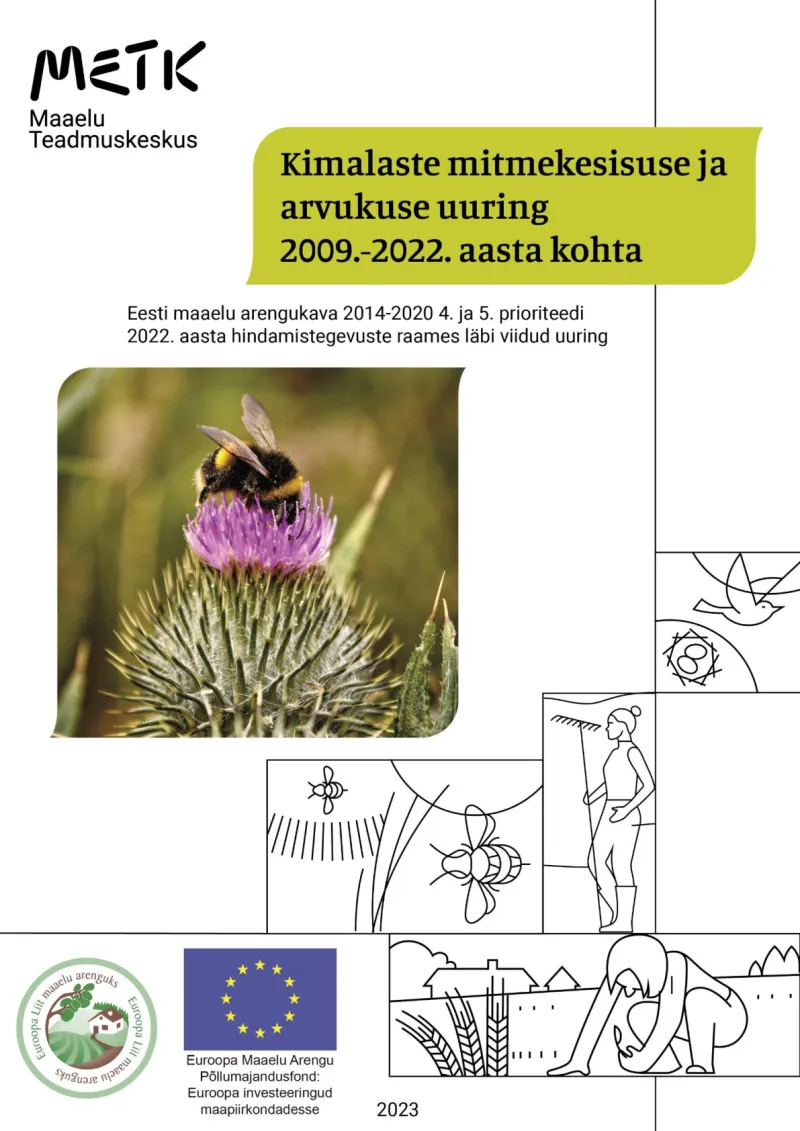Analysis of bumblebee diversity and abundance in 2009-2022
- Evaluation
- Environment
- Agricultural Productivity
- Climate and Climate Change
- Sustainability
- Evaluation
This study aims to assess the achievement of the objectives set for agri-environmental support, specifically environmentally friendly management and organic production, under the Estonian Rural Development Plan (RDP) in terms of biodiversity.
- Estonia
- 2014-2022
- Environmental impacts

The aim of the study, conducted as part of the evaluation activities of the 2014-2020 Estonian Rural Development Programme (RDP), is to assess the achievement of the objectives set for the agri-environmental support, specifically environmentally friendly management (EFM) and organic production (OF) in terms of biodiversity. The long-term study clarifies whether the implementation of these measures has protected or improved the habitat function of the land on which the support was applied.
The study analyses bumblebees in 66 monitoring areas, out of which 22 were EFM (agri-environment-climate interventions), 22 farms applying for organic farming support and 22 comparison group – not receiving RDP support but direct support (single area-based scheme). The main data is gathered in the fields, and additional data from the Paying Agency and national weather data are used.
The evaluation found that, comparing regions from 2009 to 2022, the average bumblebee indicators per census tract were, in almost all cases, higher in the southern Estonia monitoring area than in the central Estonia. Southern Estonia has a more diverse landscape, smaller farms and agricultural parcels, a higher proportion of permanent grasslands, organic farming areas, clovers and fabaceaes (except leguminous crops), an area of ≥ 2 m vegetation area, an average number of plant species visited by bumblebees and the density of flowers on census paths. Therefore, this area offers more suitable habitats and food for bumblebees.
Nevertheless, in recent years, bumblebee indicators have declined significantly in southern Estonia, reaching one of the lowest levels in 2022, during the 2009-2022 monitoring period. This may be due to the natural dynamics of bumblebee indicators. Still, at the same time, some negative trends related to agricultural land and activities from a biodiversity perspective can also be observed in southern Estonia: grassland strips have become narrower, pesticide use loads and wheat yields have increased (intensification), and areas of permanent grasslands have decreased.
Since bumblebees visit flowers to collect nectar and pollen, bumblebee indicators depend on the density of flowers – the more flowers, the higher the characteristics of the bumblebee indicators. Therefore, it is important to ensure the presence of a flowering conveyor. The average density of flowers per census tract was mostly higher in southern Estonia than in central Estonia. In addition, in central Estonia the density of flowers was highest in the areas of organic farming or EFM and the lowest in the single area-based payment scheme areas, but in southern Estonia, the highest in the areas of organic farming and the lowest in the single area-based payment areas, and recent years also in the EFM areas. The higher density of flowers in organic areas can be explained by a ban on synthetic plant protection products and most mineral fertilisers. The requirement to grow 15% leguminous crops, the restriction on the use of glyphosates, and the requirement for 2-5 m wide grassland strips may be favourable to the density of flowers in EFM areas.
It was found that the census tract had the highest number of grassland strips over 3 m wide in the EFM areas, and in central Estonia, they were the least mown. The results show that the requirement for EFM grassland strips has probably contributed to the presence of more wider grassland strips in the areas, especially in central Estonia, where there is probably also more agricultural areas of more than 20 ha for which grassland strips or other landscape features of 2-5 m wide are required under the measure.
Author(s)
Maaelu Teadmuskeskus (Centre of Estonian Rural Research and Knowledge)